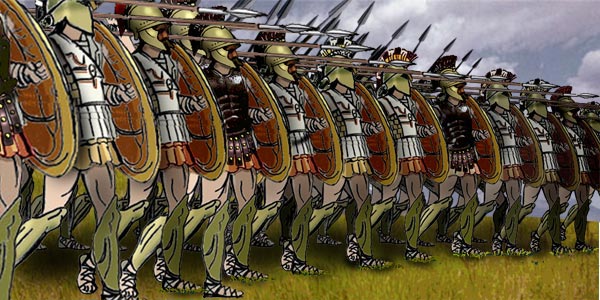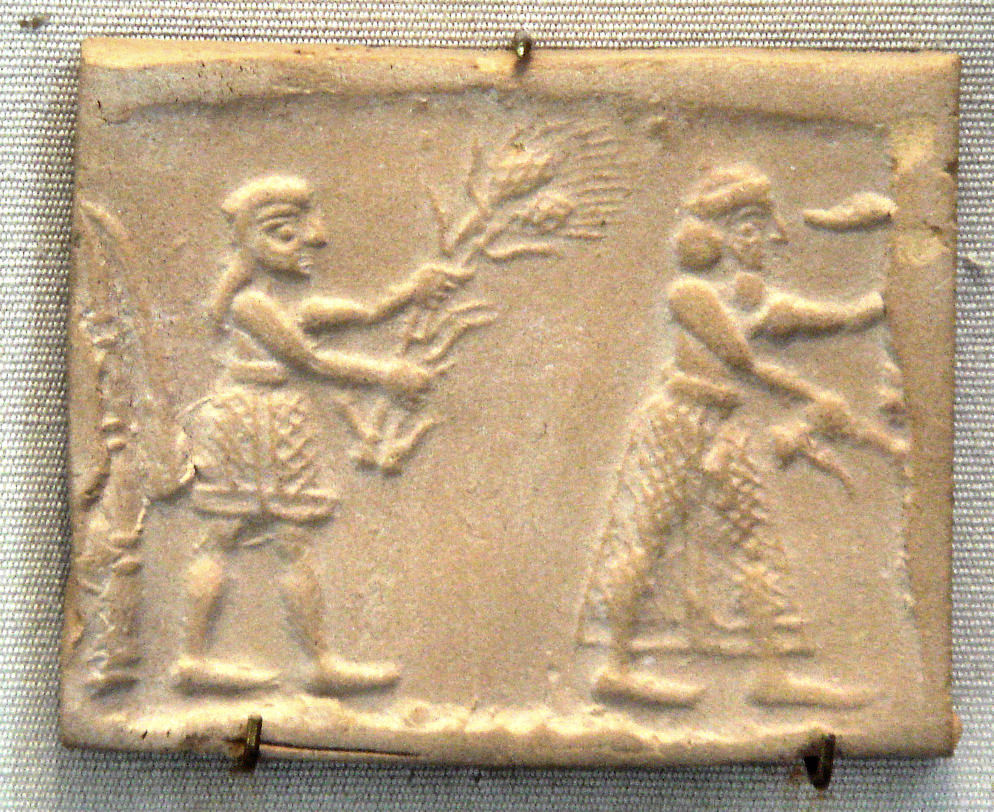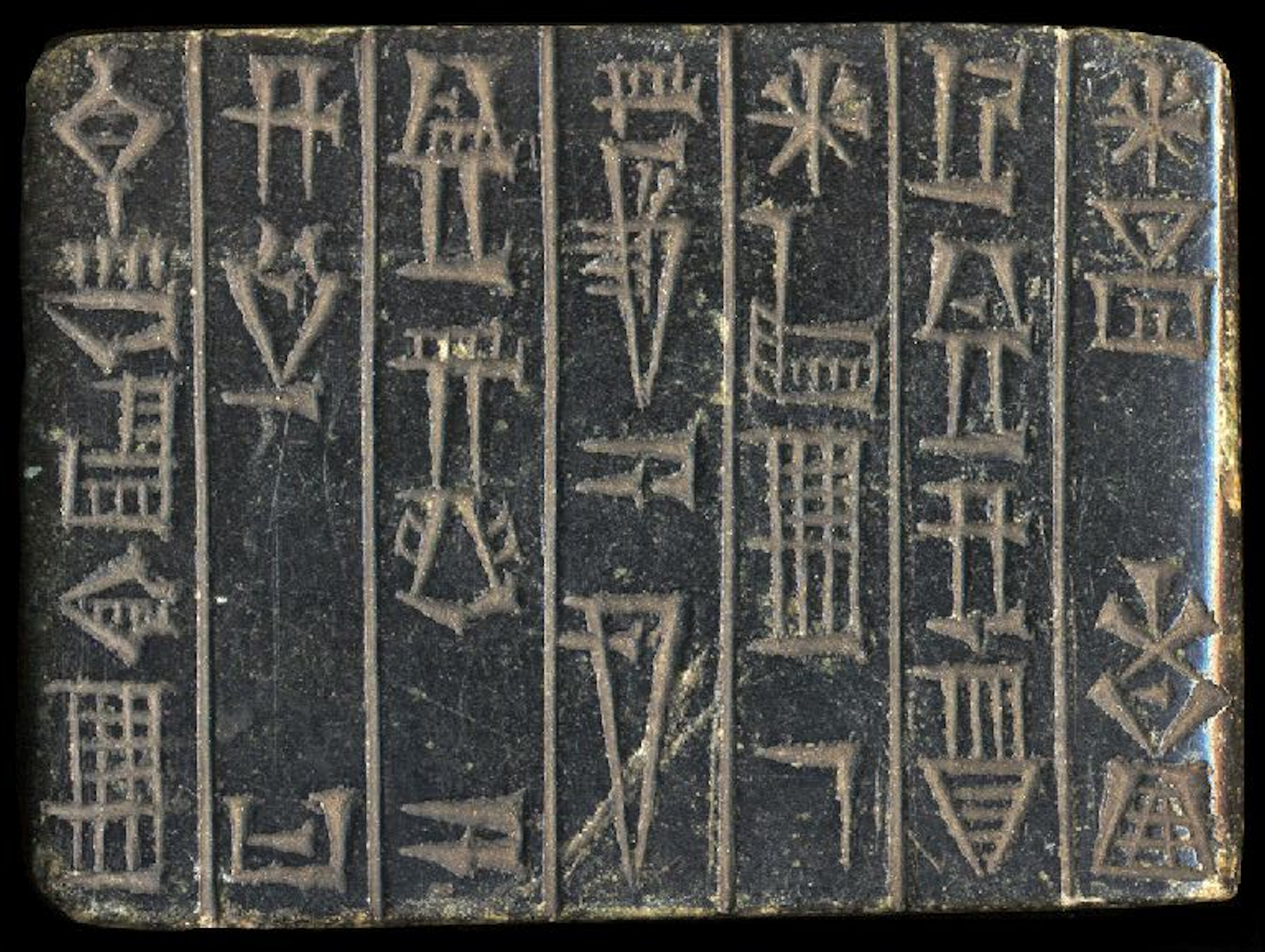|
Stele Of The Vultures
The Stele of the Vultures is a monument from the Early Dynastic Period (Mesopotamia), Early Dynastic IIIb period (2600–2350 BC) in Mesopotamia celebrating a victory of the city-state of Lagash over its neighbour Umma. It shows various battle and religious scenes and is named after the vultures that can be seen in one of these scenes. The stele was originally carved out of a single slab of limestone, but only seven fragments are known to have survived up to the present day. The fragments were found at Girsu, Tello (ancient Girsu) in southern Iraq in the 1880s and are now on display in the Musée du Louvre, Louvre. The stele was erected as a monument to the victory of king Eannatum of Lagash over Ush, king of Umma. It is the earliest known war monument. Discovery The stele is not complete; only seven fragments are known today. The first three fragments were found during excavations in the early 1880s by the French archaeologist Ernest de Sarzec at the archaeological site of Girsu, ... [...More Info...] [...Related Items...] OR: [Wikipedia] [Google] [Baidu] |
Limestone
Limestone is a type of carbonate rock, carbonate sedimentary rock which is the main source of the material Lime (material), lime. It is composed mostly of the minerals calcite and aragonite, which are different Polymorphism (materials science), crystal forms of calcium carbonate . Limestone forms when these minerals Precipitation (chemistry), precipitate out of water containing dissolved calcium. This can take place through both biological and nonbiological processes, though biological processes, such as the accumulation of corals and shells in the sea, have likely been more important for the last 540 million years. Limestone often contains fossils which provide scientists with information on ancient environments and on the evolution of life. About 20% to 25% of sedimentary rock is carbonate rock, and most of this is limestone. The remaining carbonate rock is mostly Dolomite (rock), dolomite, a closely related rock, which contains a high percentage of the mineral Dolomite (mine ... [...More Info...] [...Related Items...] OR: [Wikipedia] [Google] [Baidu] |
British Museum
The British Museum is a Museum, public museum dedicated to human history, art and culture located in the Bloomsbury area of London. Its permanent collection of eight million works is the largest in the world. It documents the story of human culture from its beginnings to the present.Among the national museums in London, sculpture and decorative art, decorative and applied art are in the Victoria and Albert Museum; the British Museum houses earlier art, non-Western art, prints and drawings. The National Gallery holds the national collection of Western European art to about 1900, while art of the 20th century on is at Tate Modern. Tate Britain holds British Art from 1500 onwards. Books, manuscripts and many works on paper are in the British Library. There are significant overlaps between the coverage of the various collections. Established in 1753, the British Museum was the first public national museum. In 2023, the museum received 5,820,860 visitors, 42% more than the previous y ... [...More Info...] [...Related Items...] OR: [Wikipedia] [Google] [Baidu] |
Gu-Edin
Gu-Edin (also transcribed "Gu'edena" or "Guedena") was a fertile plain in Sumer, in modern-day Iraq. It lay between Umma and Lagash, and claims made on it by each side were a cause of the Umma-Lagash war. Argument over the territory continued for around 150 years. Early history According to a peace between Umma and Lagash mediated by Mesilim, king of Kish (Sumer), Kish had determined where the boundary lay and the terms of use of a canal used to irrigate the land. The terms of that agreement were recorded on a stone monument called a stele, but Umma continued to feel that Lagash were unfairly advantaged by it. Reign of Eannatum It is recorded on the Stele of the Vultures that Gu-Edin was pillaged by a later (Ensi (Sumerian), énsi) of Umma, who ruled that city on behalf of its god Shara (god), Shara, and whose name, according to the Cone of Enmetena, was Ush. Gu-Edin had been claimed by the énsi of Lagash, Eannatum – author of the Stele of Vultures – as the property of L ... [...More Info...] [...Related Items...] OR: [Wikipedia] [Google] [Baidu] |
Cuneiform Script
Cuneiform is a Logogram, logo-Syllabary, syllabic writing system that was used to write several languages of the Ancient Near East. The script was in active use from the early Bronze Age until the beginning of the Common Era. Cuneiform scripts are marked by and named for the characteristic wedge-shaped impressions (Latin: ) which form their Grapheme, signs. Cuneiform is the History of writing#Inventions of writing, earliest known writing system and was originally developed to write the Sumerian language of southern Mesopotamia (modern Iraq). Over the course of its history, cuneiform was adapted to write a number of languages in addition to Sumerian. Akkadian language, Akkadian texts are attested from the 24th century BC onward and make up the bulk of the cuneiform record. Akkadian cuneiform was itself adapted to write the Hittite language in the early second millennium BC. The other languages with significant cuneiform Text corpus, corpora are Eblaite language, Eblaite, Elamit ... [...More Info...] [...Related Items...] OR: [Wikipedia] [Google] [Baidu] |
Libation
A libation is a ritual pouring of a liquid as an Sacrifice, offering to a deity or spirit, or in Veneration of the dead, memory of the dead. It was common in many religions of Ancient history, antiquity and continues to be offered in cultures today. Various substances have been used for libations, most commonly wine or other alcoholic drinks, olive oil, honey, and in India, ghee. The vessels used in the ritual, including the patera, often had a significant form which differentiated them from secular vessels. The libation could be poured onto something of religious significance, such as an altar, or into the earth. On the other hand, one or more libations began most meals and occasions when wine was drunk in Greco-Roman and other ancient societies, mostly using normal cups or jugs. Etymology The English word "libation" derives from the Latin ', an act of pouring, from the verb ', "to taste, sip; pour out, make a libation" (Indo-European root , "pour, make a libation"). Religio ... [...More Info...] [...Related Items...] OR: [Wikipedia] [Google] [Baidu] |
Vulture
A vulture is a bird of prey that scavenges on carrion. There are 23 extant species of vulture (including condors). Old World vultures include 16 living species native to Europe, Africa, and Asia; New World vultures are restricted to North and South America and consist of seven identified species, all belonging to the Cathartidae family. A particular characteristic of many vultures is a bald, unfeathered head. This bare skin is thought to keep the head clean when feeding, and also plays an important role in thermoregulation. Vultures have been observed to hunch their bodies and tuck in their heads in the cold, and open their wings and stretch their necks in the heat. They also urinate on themselves as a means of cooling their bodies. A group of vultures in flight is called a "kettle", while the term "committee" refers to a group of vultures resting on the ground or in trees. A group of vultures that are feeding is termed a "wake". Taxonomy Although New World vulture ... [...More Info...] [...Related Items...] OR: [Wikipedia] [Google] [Baidu] |
Phalanx Formation
The phalanx (: phalanxes or phalanges) was a rectangular mass military Tactical formation, formation, usually composed entirely of heavy infantry armed with spears, pike (weapon), pikes, sarissas, or similar polearms tightly packed together. The term is particularly used to describe the use of this formation in ancient Greek warfare, although the ancient Greek writers used it to also describe any massed infantry formation, regardless of its equipment. Arrian uses the term in his ''Array against the Alans'' when he refers to his legions. In Greek texts, the phalanx may be deployed for battle, on the march, or even camped, thus describing the mass of infantry or cavalry that would deploy in line during battle. They marched forward as one entity. The term itself, as used today, does not refer to a distinctive military unit or division (e.g., the Roman legion or the contemporary Western-type battalion), but to the type of formation of an army's troops. Therefore, this term does not ... [...More Info...] [...Related Items...] OR: [Wikipedia] [Google] [Baidu] |
Ensí
Ensi (cuneiform: , "lord of the plowland"; Emesal dialect: ''umunsik''; ) was a Sumerian title designating the ruler or prince of a city-state. Originally it may have designated an independent ruler, but in later periods the title presupposed subordinance to a lugal. For the Early Dynastic Period (about 2800–2350 BC), the meaning of the titles en, ensi and lugal cannot be differentiated clearly: see lugal, ensi and en for details. Ensi may have originally been a designation of the ruler restricted to Lagash and Umma. The ''ensi'' was considered a representative of the city-state's patron deity. In later periods, an ensi was normally seen as subordinate to a lugal. Nevertheless, even the powerful rulers of the Second Dynasty of Lagash () such as Gudea were satisfied with the title ensi. During the Third Dynasty of Ur (about 2100–2000 BC) ensi referred to the provincial governors of the kingdom. These exercised great powers in terms of government, tax revenue and juris ... [...More Info...] [...Related Items...] OR: [Wikipedia] [Google] [Baidu] |
Stele Of Vultures Detail 02
A stele ( ) or stela ( )The plural in English is sometimes stelai ( ) based on direct transliteration of the Greek, sometimes stelae or stelæ ( ) based on the inflection of Greek nouns in Latin, and sometimes anglicized to steles ( ) or stelas ( ). is a stone or wooden slab, generally taller than it is wide, erected in the ancient world as a monument. The surface of the stele often has text, ornamentation, or both. These may be inscribed, carved in relief, or painted. Stelae were created for many reasons. Grave stelae were used for funerary or commemorative purposes. Stelae as slabs of stone would also be used as ancient Greek and Roman government notices or as boundary markers to mark borders or property lines. Stelae were occasionally erected as memorials to battles. For example, along with other memorials, there are more than half-a-dozen steles erected on the battlefield of Waterloo at the locations of notable actions by participants in battle. A traditional Western gra ... [...More Info...] [...Related Items...] OR: [Wikipedia] [Google] [Baidu] |
Ninhursag
Ninḫursaĝ ( ''Ninḫarsang''; ), sometimes transcribed Ninursag, Ninḫarsag, or Ninḫursaĝa, also known as Damgalnuna or Ninmah, was the ancient Sumerian mother goddess of the mountains, and one of the seven great deities of Sumer. She is known earliest as a nurturing or fertility goddess. Temple hymn sources identify her as the "true and great lady of heaven" (possibly in relation to her standing on the mountain) and kings of Lagash were "nourished by Ninhursag's milk". She is the tutelary deity to several Sumerian leaders. Her best-known myths are ''Enki and Ninhursag'' describing her dealings with Enki resulting from his sexual exploits, and ''Enki and Ninmah'' a creation myth wherein the two deities compete to create humans. She is referenced or makes brief appearances in others as well, most notably as the mother of Ninurta in the Anzû Epic. Name Ninhursag means "lady of the sacred mountain" from Sumerian NIN "lady" and ḪAR.SAG̃ "sacred mountain, foothil ... [...More Info...] [...Related Items...] OR: [Wikipedia] [Google] [Baidu] |
Ninurta
Ninurta (: , possible meaning "Lord [of] Barley"), also known as Ninĝirsu (: , meaning "Lord [of] Girsu"), is an List of Mesopotamian deities, ancient Mesopotamian god associated with farming, healing, hunting, law, scribes, and war who was first worshipped in early Sumer. In the earliest records, he is a god of agriculture and healing, who cures humans of sicknesses and releases them from the power of Demons#Mesopotamia, demons. In later times, as Mesopotamia grew more militarized, he became a warrior deity, though he retained many of his earlier agricultural attributes. He was regarded as the son of the chief god Enlil and his main Cult (religious practice), cult center in Sumer was the Eshumesha temple in Nippur. Ninĝirsu was honored by Gudea, King Gudea of Lagash (ruled 2144–2124 BC), who rebuilt Ninĝirsu's temple in Lagash. Later, Ninurta became beloved by the Assyrians as a formidable warrior. The Assyrian king Ashurnasirpal II (ruled 883–859 BC) built a massive tem ... [...More Info...] [...Related Items...] OR: [Wikipedia] [Google] [Baidu] |
Zu (mythology)
Zu or ZU may refer to: Arts, entertainment and mythology Fictional elements * Zu (mythology), an Akkadian god * Zu, a mountain featured in the films ''Zu Warriors from the Magic Mountain'' and ''The Legend of Zu'' * Zu, a large birdlike monster from the ''Final Fantasy'' series Other uses in arts and entertainment * Zu (band), an Italian hardcore/jazz band * ''zu'' and ''zun'', types of ancient Chinese ritual bronzes Cuisine * Zu (beverage), an alcoholic rice drink from Mizoram. Language * There are Yotsugana, two different kana (Japanese script) letters that are romanized as ''zu'': ** ず: Su (kana), Su (す) with dakuten (voicing marks) ** づ: Tsu (kana), Tsu (つ) with dakuten; in modern standard Japanese primarily used for indicating a voiced consonant in the middle of a compound word, and can never begin a word * Zu (cuneiform), a sign in cuneiform writing * Zulu language, ISO 639-2 code:zu People and titles * Zu (surname) (祖), a Chinese surname * Zu, a nobiliary partic ... [...More Info...] [...Related Items...] OR: [Wikipedia] [Google] [Baidu] |









